Self-Compassion May Have Benefits for Body Image among Women with a Higher Body Mass Index and Internalized Weight Bias
Abstract
1. Introduction
2. Materials and Methods
2.1. Participants
2.2. Measures
2.2.1. Body Mass Index (BMI)
2.2.2. Modified Weight Bias Internalization Scale (WBIS-M [42])
2.2.3. Visual Analogue Scales (VAS) for Body Satisfaction and Dissatisfaction
2.2.4. International Positive and Negative Affect Schedule-Short Form (I-PANAS-SF [47])
2.2.5. Self-Compassion Scale (SCS [18])
2.2.6. Body Image States Scale (BISS [49])
2.2.7. State Self-Esteem Scale (SSES [50])
2.3. Procedures
3. Results
3.1. The Impact of the Letter-Writing Exercises on Body (Dis)Satisfaction
3.2. Group Differences following the Letter-Writing Exercise
3.3. Exploratory Analysis
4. Discussion
5. Conclusions
Author Contributions
Funding
Institutional Review Board Statement
Informed Consent Statement
Data Availability Statement
Conflicts of Interest
References
- Rodin, J.; Silberstein, L.; Striegel-Moore, R. Women and weight: A normative discontent. Neb. Symp. Motiv. 1984, 32, 267. [Google Scholar]
- Garner, D.M.; Garfinkel, P.E.; Schwartz, D.; Thompson, M. Cultural expectations of thinness in women. Psychol. Rep. 1980, 47, 483–491. [Google Scholar] [CrossRef] [PubMed]
- Bessenoff, G.R. Can the media affect us? Social comparison, self-discrepancy, and the thin ideal. Psychol. Women Q. 2006, 30, 239–251. [Google Scholar] [CrossRef]
- Fallon, E.A.; Hausenblas, H.A. Media images of the “ideal” female body: Can acute exercise moderate their psychological impact? Body Image 2005, 2, 62–73. [Google Scholar] [CrossRef] [PubMed]
- Harper, B.; Tiggemann, M. The effect of thin ideal media images on women’s self-objectification, mood, and body image. Sex Roles 2008, 58, 649–657. [Google Scholar] [CrossRef]
- Thompson, J.K.; Stice, E. Thin-ideal internalization: Mounting evidence for a new risk factor for body-image disturbance and eating pathology. Curr. Dir. Psychol. Sci. 2001, 10, 181–183. [Google Scholar] [CrossRef]
- Stice, E.; Shaw, H.E. Role of body dissatisfaction in the onset and maintenance of eating pathology: A synthesis of research findings. J. Psychosom. Res. 2002, 53, 985–993. [Google Scholar] [CrossRef]
- Betz, D.E.; Ramsey, L.R. Should women be “All About That Bass?”: Diverse body-ideal messages and women’s body image. Body Image 2017, 22, 18–31. [Google Scholar] [CrossRef]
- Fredrickson, B.L.; Roberts, T.A. Objectification theory: Toward understanding women’s lived experiences and mental health risks. Psychol. Women Q. 1997, 21, 173–206. [Google Scholar] [CrossRef]
- Rosewall, J.K.; Gleaves, D.H.; Latner, J.D. Psychopathology factors that affect the relationship between body size and body dissatisfaction and the relationship between body dissatisfaction and eating pathology. Front. Psychol. 2018, 9, 2768. [Google Scholar] [CrossRef]
- Choi, E.; Choi, I. The associations between body dissatisfaction, body figure, self-esteem, and depressed mood in adolescents in the United States and Korea: A moderated mediation analysis. J. Adolesc. 2016, 53, 249–259. [Google Scholar] [CrossRef] [PubMed]
- Bornioli, A.; Lewis-Smith, H.; Smith, A.; Slater, A.; Bray, I. Adolescent body dissatisfaction and disordered eating: Predictions of later risky health behaviours. Soc. Sci. Med. 2019, 238, 112458. [Google Scholar] [CrossRef] [PubMed]
- Mars, B.; Heron, J.; Klonsky, E.D.; Moran, P.; O’Conner, R.C.; Tilling, K.; Wilkinson, P.; Gunnell, D. What distinguishes adolescents with suicidal thoughts from those who have attempted suicide? A population-based birth cohort study. J. Child Psychol. Psychiatry 2018, 60, 91–99. [Google Scholar] [CrossRef] [PubMed]
- Albertson, E.R.; Neff, K.D.; Dill-Shackleford, K.E. Self-compassion and body dissatisfaction in women: A randomized controlled trial of a brief meditation intervention. Mindfulness 2014, 6, 444–454. [Google Scholar] [CrossRef]
- Toole, A.M.; Craighead, L.W. Brief self-compassion meditation training for body image distress in young adult women. Body Image 2016, 19, 104–112. [Google Scholar] [CrossRef]
- David, L.A. The Impact of Cognitive Restructuring and Self-Compassion Strategies on Negative Body Image among Women with Higher Body Weight: An Experimental Investigation. Unpublished Doctoral Dissertation, Toronto Metropolitan University, Toronto, ON, Canada, 2018. [Google Scholar]
- Forbes, Y.N.; Moffitt, R.L.; Van Bokkel, M.; Donovan, C.L. Unburdening the weight of stigma: Findings from a compassion-focused group program for women with overweight and obesity. J. Cogn. Psychother. 2020, 34, 336–357. [Google Scholar] [CrossRef]
- Neff, K.D. The development and validation of a scale to measure self-compassion. Self Identity 2003, 2, 223–250. [Google Scholar] [CrossRef]
- De Souza, L.K.; Hutz, C.S. Self-compassion in relation to self-esteem, self-efficacy, and demographic aspects. Paidéia 2016, 26, 181–188. [Google Scholar] [CrossRef]
- Przezdziecki, A.; Sherman, K.A. Modifying affective and cognitive responses regarding body image difficulties in breast cancer survivors using a self-compassion-based writing intervention. Mindfulness 2016, 7, 1142–1155. [Google Scholar] [CrossRef]
- Ferreira, C.; Pinto-Gouveia, J.; Duarte, C. Self-compassion in the face of shame and body image dissatisfaction: Implications for eating disorders. Eat. Behav. 2013, 14, 207–210. [Google Scholar] [CrossRef]
- Breines, J.; Toole, A.; Tu, C.; Chen, S. Self-compassion, body image, and self-reported disordered eating. Self Identity 2014, 13, 432–448. [Google Scholar] [CrossRef]
- Homan, K.J.; Tylka, T.L. Self-compassion moderates body comparison and appearance self-worth’s inverse relationships with body appreciation. Body Image 2015, 15, 1–7. [Google Scholar] [CrossRef]
- Slater, A.; Varsani, N.; Diedrichs, P.C. #fitspo or #loveyourself? The impact of fitspiration and self-compassion Instagram images on women’s body image, self-compassion, and mood. Body Image 2017, 22, 87–96. [Google Scholar] [CrossRef]
- Sira, B.; Ballard, S.M. An ecological approach to examining body satisfaction in Caucasian and African American female college students. Fam. Consum. Sci. Res. J. 2009, 38, 208–226. [Google Scholar] [CrossRef]
- Haley, E.N.; Dolbier, C.L.; Carels, R.A.; Whited, M.C. A brief pilot self-compassion intervention for women with overweight/obesity and internalized weight bias: Feasibility, acceptability, and future directions. J. Context. Behav. Sci. 2022, 23, 59–63. [Google Scholar] [CrossRef]
- Falkner, N.H.; French, S.A.; Jeffery, R.W.; Neumark-Sztainer, D.; Sherwood, N.E.; Morton, N. Mistreatment due to weight: Prevalence and sources of perceived mistreatment in women and men. Obes. Res. 1999, 7, 572–576. [Google Scholar] [CrossRef] [PubMed]
- Brochu, P.M.; Esses, V.M. What’s in a name? The effects of the labels “fat” versus “overweight” on weight bias. J. Appl. Soc. Psychol. 2011, 41, 1981–2008. [Google Scholar] [CrossRef]
- Lillis, J.; Luoma, J.B.; Levin, M.E.; Hayes, S.C. Measuring weight self-stigma: The weight self-stigma questionnaire. Obesity 2010, 18, 971–976. [Google Scholar] [CrossRef]
- Durso, L.E.; Latner, J.D.; Ciao, A.C. Weight bias internalization in treatment-seeking overweight adults: Psychometric validation and associations with self-esteem, body image, and mood symptoms. Eat. Behav. 2016, 21, 104–108. [Google Scholar] [CrossRef]
- Pearl, R.L.; Puhl, R.M. The distinct effects of internalizing weight bias: An experimental study. Body Image 2016, 17, 38–42. [Google Scholar] [CrossRef]
- Fekete, E.M.; Herndier, R.E.; Sander, A.C. Self-compassion, internalized weight stigma, psychological well-being, and eating behaviors in women. Mindfulness 2021, 12, 1262–1271. [Google Scholar] [CrossRef]
- Roberto, C.A.; Sysko, R.; Bush, J.; Pearl, R.; Puhl, R.M.; Schvey, N.A.; Dovidio, J.F. Clinical correlates of the Weight Bias Internalization Scale in a sample of obese adolescents seeking bariatric surgery. Obesity 2012, 20, 533–539. [Google Scholar] [CrossRef]
- Pullmer, R.; Kerrigan, S.G.; Grilo, C.M.; Lydecker, J.A. Factors linking perceived discrimination and weight bias internalization to body appreciation and eating pathology: A moderated mediation analysis of self-compassion and psychological distress. Stigma Health 2021, 6, 6–494. [Google Scholar] [CrossRef]
- Hilbert, A.; Braehler, E.; Schmidt, R.; Lӧwe, B.; Hӓuser, W.; Zenger, M. Self-compassion as a resource in the self-stigma process of overweight and obese individuals. Obes. Facts 2015, 8, 293–301. [Google Scholar] [CrossRef] [PubMed]
- Faul, F.; Erdfelder, E.; Buchner, A.; Lang, A.-G. Statistical power analyses using G*Power 3.1: Tests for correlation and regression analyses. Behav. Res. Methods 2009, 41, 1149–1160. [Google Scholar] [CrossRef]
- Bardone-Cone, A.M.; Cass, K.M.; Ford, J.A. Examining body dissatisfaction in young men within a biopsychosocial framework. Body Image 2008, 5, 183–194. [Google Scholar] [CrossRef]
- Cafri, G.; Thompson, J.K. Measuring male body image: A review of the current methodology. Psychol. Men Masc. 2004, 5, 18–29. [Google Scholar] [CrossRef]
- National Heart, Lung, and Blood Institute. (n.d.). Calculate Your BMI—Standard BMI Calculator. Available online: https://www.nhlbi.nih.gov/health/educational/lose_wt/BMI/bmicalc.htm (accessed on 23 May 2019).
- Humphreys, S. The unethical use of BMI in contemporary general practice. Br. J. Gen. Pract. 2010, 60, 696–697. [Google Scholar] [CrossRef]
- Nutall, F.Q. Body Mass Index: Obesity, BMI, and health: A critical review. Nutr. Today 2015, 50, 117–128. [Google Scholar] [CrossRef]
- Pearl, R.L.; Puhl, R.M. Measuring internalized weight attitudes across body weight categories: Validation of the Modified Weight Bias Internalization Scale. Body Image 2014, 11, 89–92. [Google Scholar] [CrossRef] [PubMed]
- Durso, L.E.; Latner, J.D. Understanding self-directed stigma: Development of the Weight Bias Internalization Scale. Obesity 2008, 16, S80–S86. [Google Scholar] [CrossRef]
- Abend, R.; Dan, O.; Maoz, K.; Raz, S.; Bar-Haim, Y. Reliability, validity, and sensitivity of a computerized visual analog scale measuring state anxiety. J. Behav. Ther. Exp. Psychiatry 2014, 45, 447–453. [Google Scholar] [CrossRef] [PubMed]
- Heinberg, L.J.; Thompson, J.K. Body image and televised images of thinness and attractivess: A controlled laboratory investigation. J. Soc. Clin. Psychol. 1995, 14, 325–328. [Google Scholar] [CrossRef]
- Garner, D.M.; Olmsted, M.P.; Polivy, J. Development and validation of a multidimensional eating disorder inventory for anorexia nervosa and bulimia. Int. J. Eat. Disord. 1983, 2, 15–34. [Google Scholar] [CrossRef]
- Thompson, E.R. Development and validation of an internationally reliable short-form of the positive and negative affect schedule (PANAS). J. Cross-Cult. Psychol. 2007, 38, 227–242. [Google Scholar] [CrossRef]
- Watson, D.; Clark, L.A.; Tellegen, A. Development and validation of brief measures of positive and negative affect: The PANAS scales. J. Personal. Soc. Psychol. 1998, 54, 1063–1070. [Google Scholar] [CrossRef]
- Cash, T.F.; Fleming, E.C.; Alindogan, J.; Steadman, L.; Whitehead, A. Beyond body image as a trait: The development and validation of the Body Image States Scale. Eat. Disord. 2002, 10, 103–113. [Google Scholar] [CrossRef]
- Heatherton, T.F.; Polivy, J. Development and validation of a scale for measuring state self-esteem. J. Personal. Soc. Psychol. 1991, 60, 895–910. [Google Scholar] [CrossRef]
- Helm, L. The Effect of a Brief Self-Compassion Intervention on Emotion Regulation in Individuals with Generalized Anxiety Disorder. Ph.D. Dissertation, Alliant International University, San Diego, CA, USA, 2016, unpublished. [Google Scholar]
- Gonen, M.L. Does the Induction of Self-Compassion Buffer Negative Affect in Those Exposed to Social Evaluation? Ph.D. Dissertation, Hofstra University, Hempstead, NY, USA, 2015, unpublished. [Google Scholar]
- Ziemer, K.S.; Lamphere, B.R.; Raque-Bogdan, T.L.; Schmidt, C.K. A randomized controlled study of writing interventions on college women’s positive body image. Mindfulness 2019, 10, 66–77. [Google Scholar] [CrossRef]
- Kelly, A.C.; Waring, S.V. A feasibility study of a 2-week self-compassionate letter-writing intervention for nontreatment seeking individuals with typical and atypical anorexia nervosa. Int. J. Eat. Disord. 2018, 51, 1005–1009. [Google Scholar] [CrossRef]
- Field, A. Discovering Statistics Using IBM SPSS Statistics, 5th ed.; Sage: Los Angeles, CA, USA, 2018. [Google Scholar]
- Leary, M.R.; Tate, E.B.; Adams, C.E.; Allen, A.B.; Hancock, J. Self-compassion and reactions to unpleasant self-relevant events: The implications of treating oneself kindly. J. Personal. Soc. Psychol. 2007, 92, 887–904. [Google Scholar] [CrossRef] [PubMed]
- Seekis, V.; Bradley, G.L.; Duffy, A. The effectiveness of self-compassion and self-esteem writing tasks in reducing body image concerns. Body Image 2017, 23, 206–213. [Google Scholar] [CrossRef] [PubMed]
- Stern, N.G.; Engeln, R. Self-compassionate writing exercises increase college women’s body satisfaction. Psychol. Women Q. 2018, 42, 326–341. [Google Scholar] [CrossRef]
- Boyraz, G.; Legros, D.N.; Berger, W.B. Self-criticism, self-compassion, and perceived health: Moderating effect of ethnicity. J. Gen. Psychol. 2020, 148, 149–167. [Google Scholar] [CrossRef]
- Lockard, A.J.; Hayes, J.A.; Neff, K.; Locke, B.D. Self-compassion among college counseling centre clients: An examination of clinical norms and group differences. J. Coll. Couns. 2014, 17, 249–259. [Google Scholar] [CrossRef]
- Moffitt, R.L.; Neumann, D.L.; Williamson, S.P. Comparing the efficacy of a brief self-esteem and self-compassion intervention for state body dissatisfaction and self-improvement motivation. Body Image 2018, 27, 67–76. [Google Scholar] [CrossRef]
- Grabe, S.; Hyde, J.S. Ethnicity and body dissatisfaction among women in the United States: A meta-analysis. Psychol. Bull. 2006, 132, 622–640. [Google Scholar] [CrossRef]

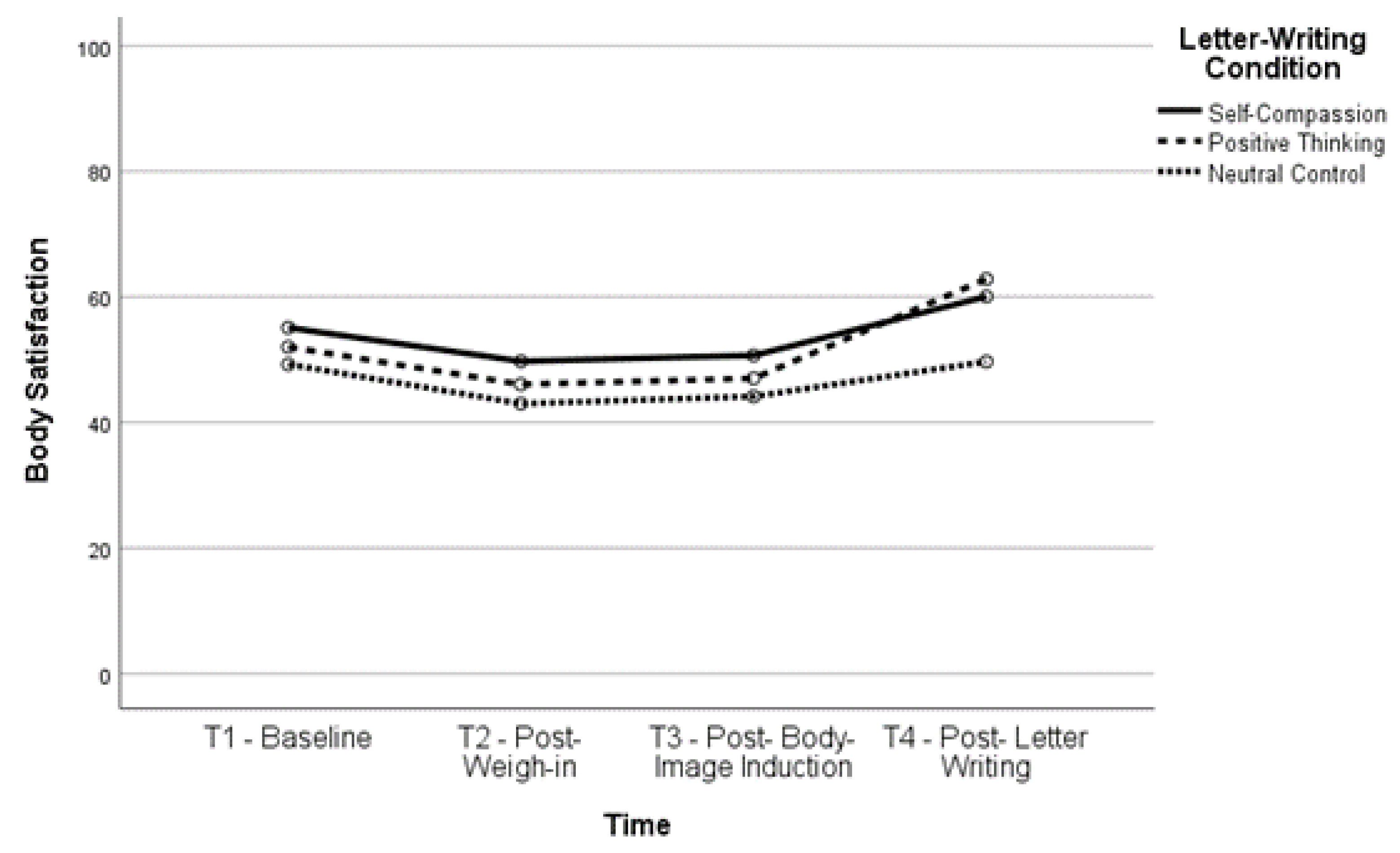
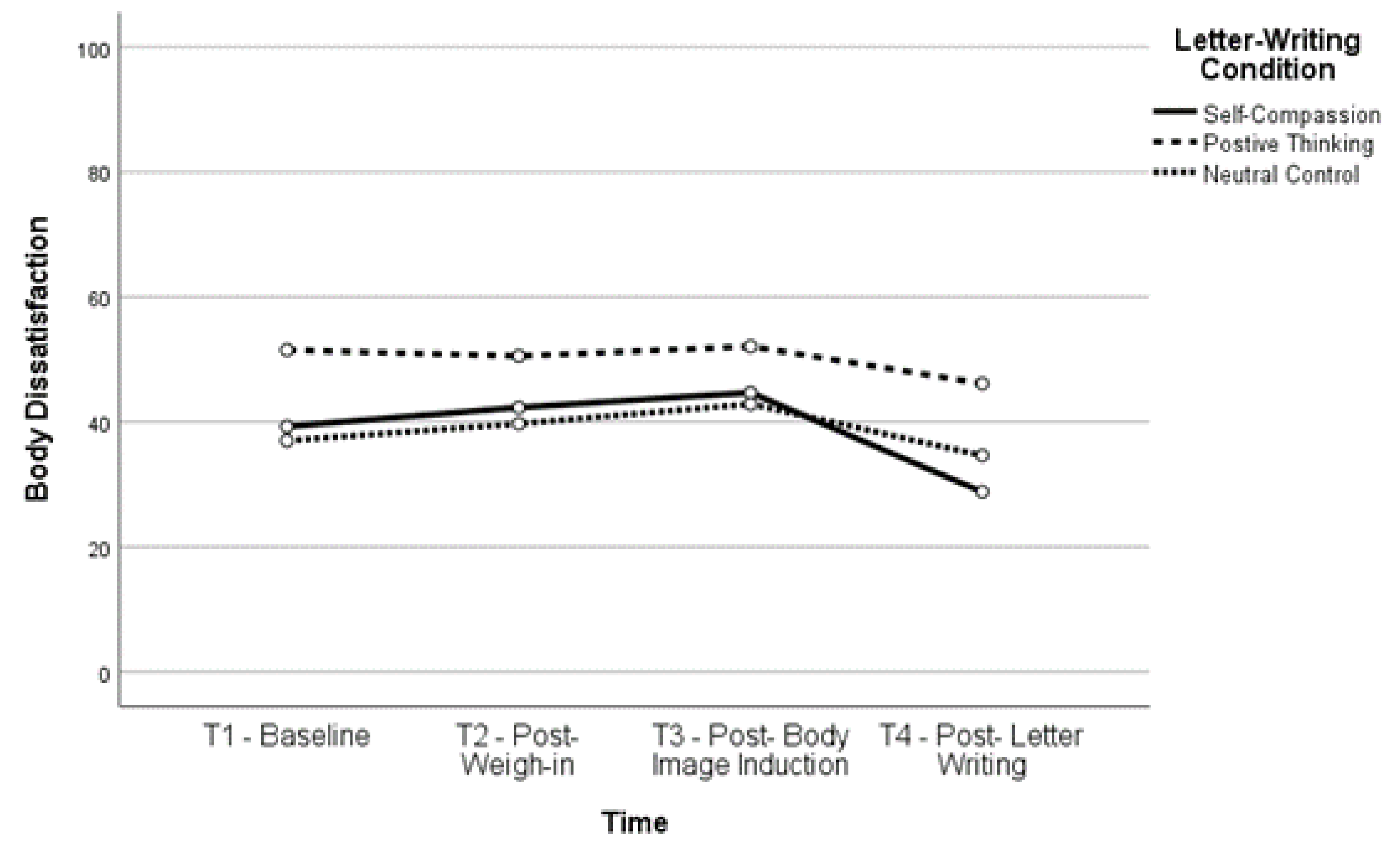
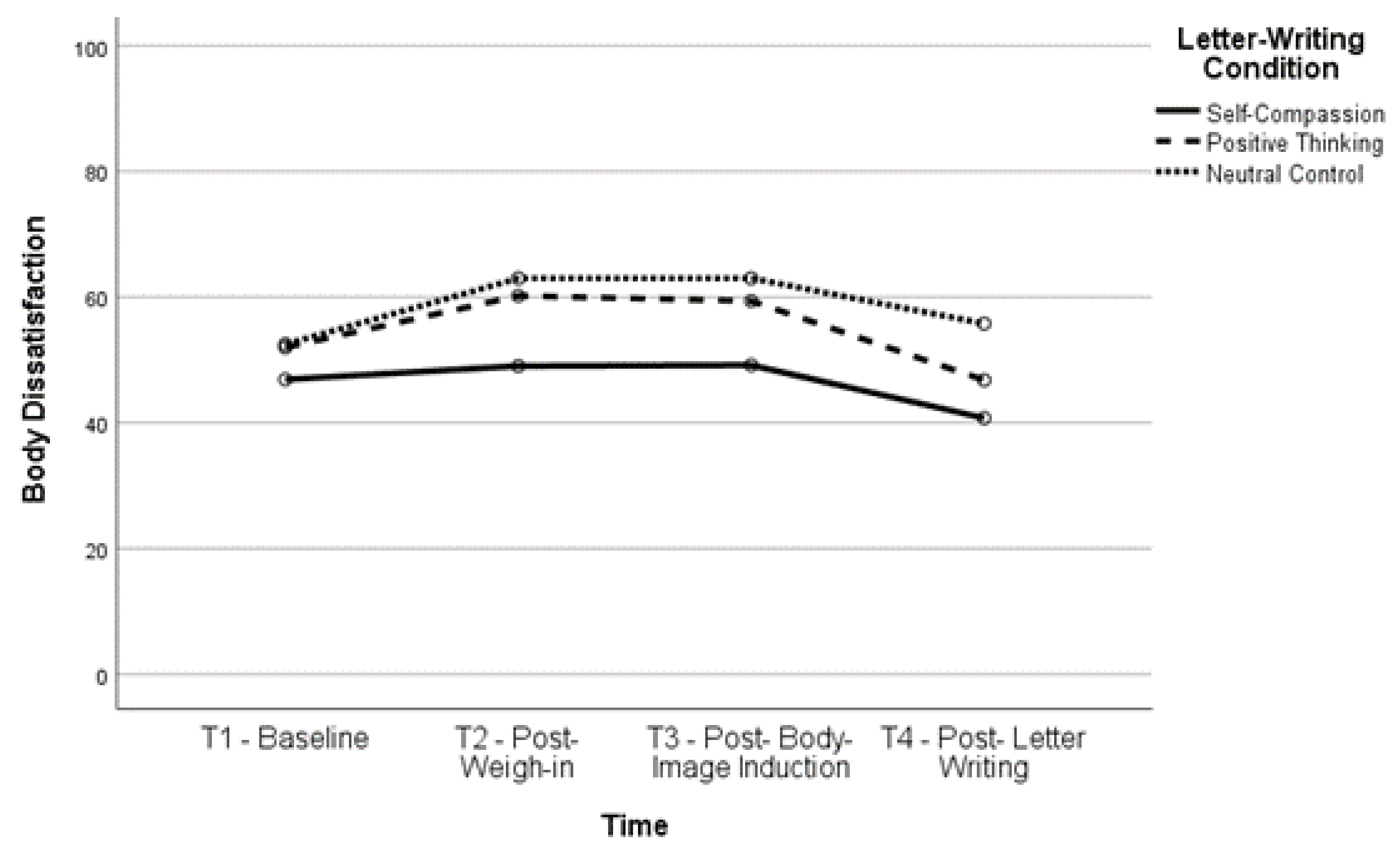
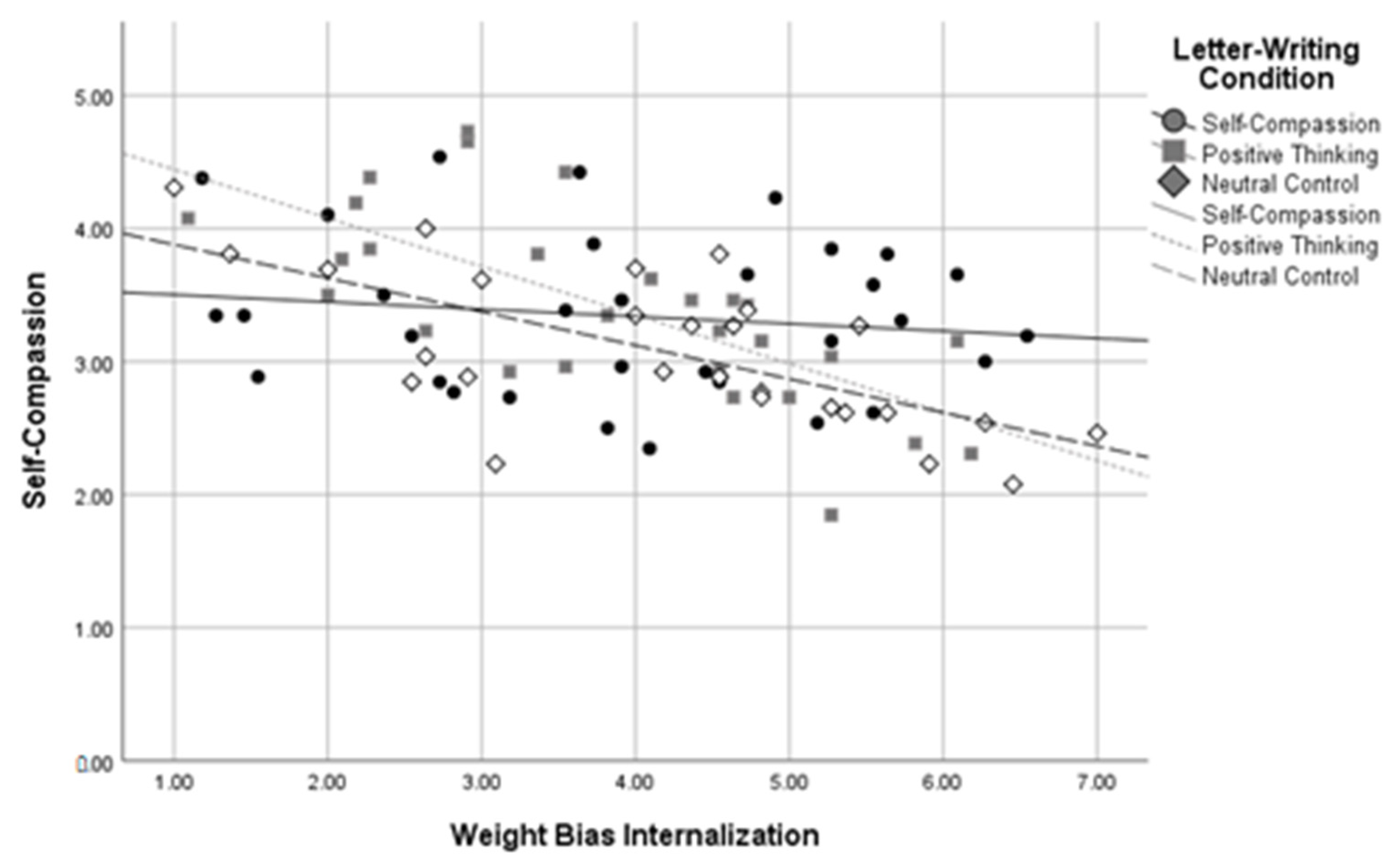
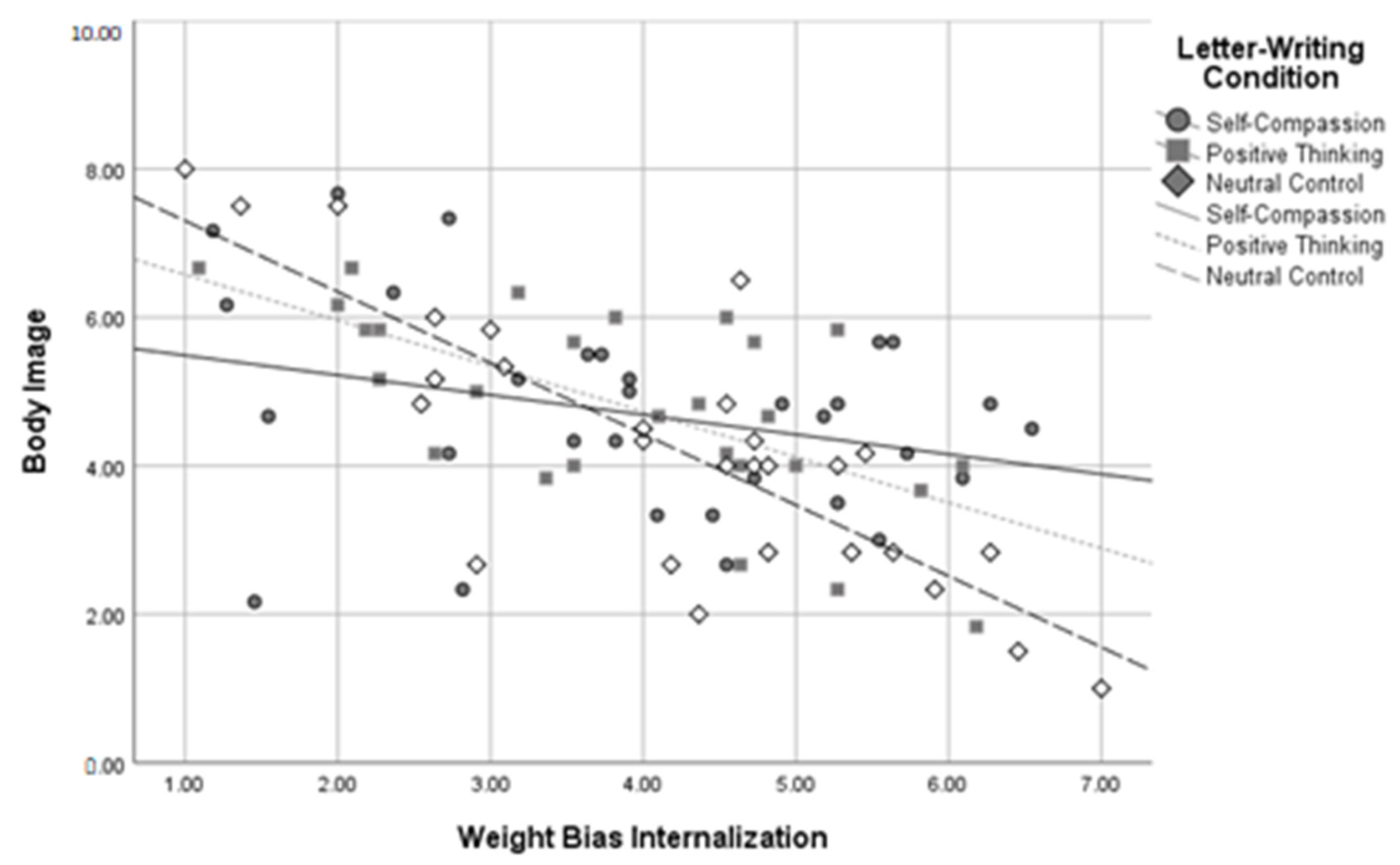
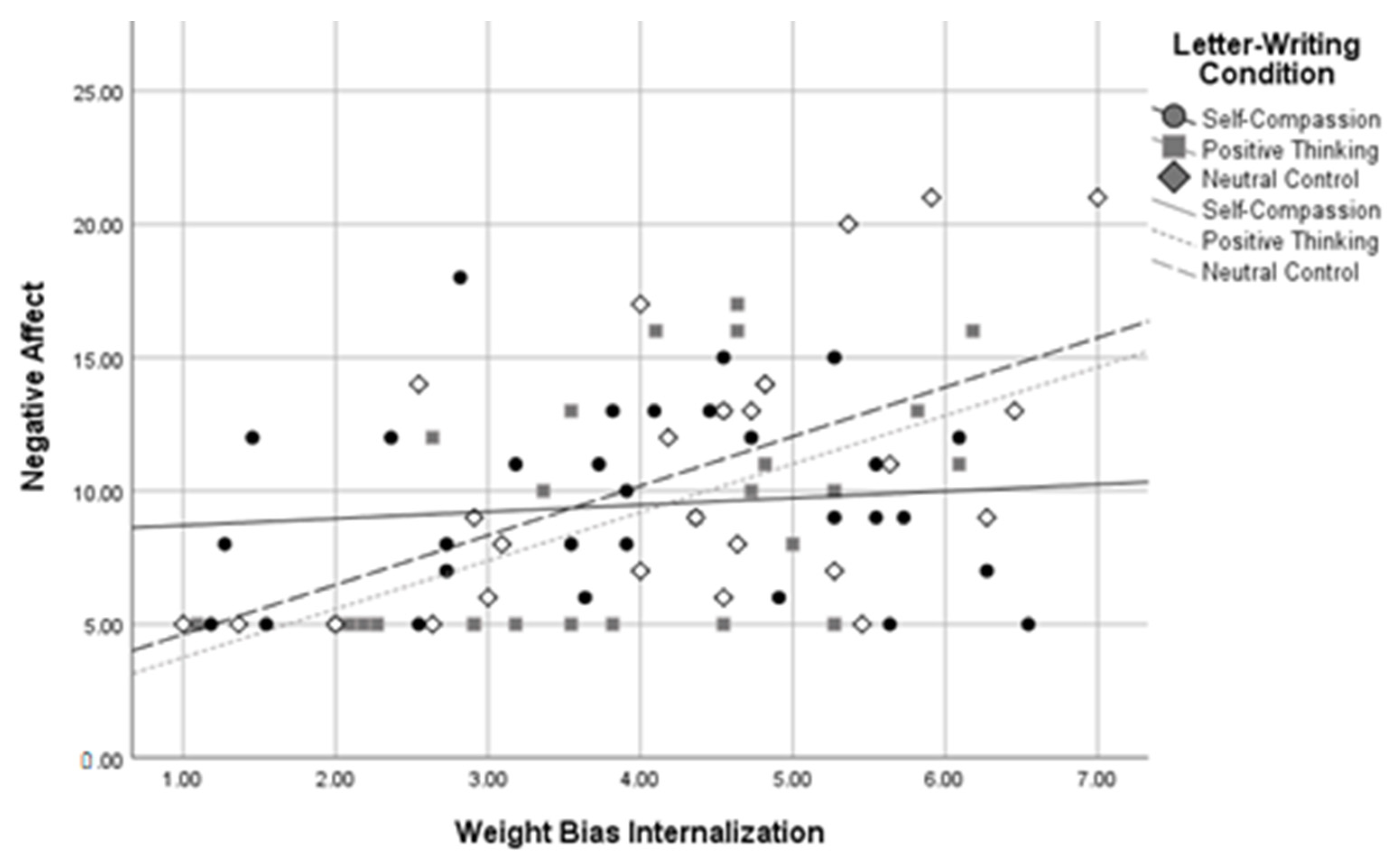
| Variable | Self-Compassion | Positive Thinking | Neutral Control | |||
|---|---|---|---|---|---|---|
| HBMI * | LBMI * | HBMI | LBMI | HBMI | LBMI | |
| Age | 22.45 (7.00) | 19.87(2.32) | 20.17 (3.23) | 19.96 (3.38) | 22.04 (6.74) | 20.72 (7.11) |
| BMI | 29.29 (2.75) | 21.49(2.69) | 28.93 (3.24) | 21.40 (2.63) | 29.68 (5.23) | 21.52 (2.11) |
| Ethnic Group | ||||||
| White | 15 (46.88%) | 10 (38.46%) | 14 (50.00%) | 10 (38.46%) | 8 (28.57%) | 10 (37.04%) |
| South Asian | 4 (12.50%) | 4 (15.38%) | 5 (17.86%) | 5 (19.23%) | 8 (28.57%) | 4 (14.81%) |
| East Asian | 0 (0%) | 8 (30.77%) | 1 (3.57%) | 8 (30.77%) | 1 (3.57%) | 5 (18.52%) |
| Black | 4 (12.50%) | 0 (0%) | 5 (17.86%) | 1 (3.85%) | 2 (7.14%) | 2 (7.41%) |
| Arabic/Middle Eastern | 2 (6.25%) | 0 (0%) | 0 (0%) | 1 (3.85%) | 4 (14.29%) | 1 (3.70%) |
| Hispanic/Latina | 1 (3.13%) | 0 (0%) | 2 (7.14%) | 0 (0%) | 2 (7.14%) | 0 (0%) |
| Indigenous | 0 (0%) | 0 (0%) | 0 (0%) | 0 (0%) | 1 (3.57%) | 0 (0%) |
| Other | 6 (18.75%) | 4 (15.38%) | 1 (3.57%) | 1 (3.85%) | 2 (7.14%) | 5 (18.52%) |
| Education Level | ||||||
| 1st year | 21 (65.63%) | 16 (61.54%) | 17 (60.71%) | 13 (50.00%) | 17 (60.71%) | 16 (59.26%) |
| 2nd year | 1 (3.13%) | 3 (11.54%) | 0 (0%) | 3 (11.54%) | 6 (21.43%) | 3 (11.11%) |
| 3rd year | 5 (15.63%) | 5 (19.23%) | 5 (17.86%) | 5 (19.23%) | 1 (3.57%) | 5 (18.52%) |
| 4th year or beyond | 5 (15.63%) | 2 (7.69%) | 6 (21.43%) | 5 (19.23%) | 4 (14.29%) | 3 (11.11%) |
| Variable | Self-Compassion | Positive Thinking | Neutral Control | |||
|---|---|---|---|---|---|---|
| HBMI * | LBMI * | HBMI | LBMI | HBMI | LBMI | |
| Self-Compassion | 3.34 (0.59) | 3.48 (0.55) | 3.40 (0.71) | 3.31 (0.55) | 3.07 (0.58) | 3.25 (0.54) |
| Self-Esteem | 61.85 (14.60) | 65.00 (13.60) | 63.17 (14.57) | 64.41 (16.62) | 58.04 (18.53) | 62.01 (14.06) |
| Body Image | 4.70 (1.36) | 5.74 (1.45) | 4.80 (1.30) | 5.32 (1.31) | 4.23 (1.81) | 5.14 (1.31) |
| Positive Affect | 15.65 (3.82) | 15.04 (3.80) | 16.75 (4.21) | 15.00 (3.48) | 15.41 (4.07) | 13.58 (5.05) |
| Negative Affect | 9.45 (3.51) | 8.52 (4.23) | 8.93 (4.25) | 8.65 (4.64) | 10.65 (5.08) | 8.11 (3.32) |
Disclaimer/Publisher’s Note: The statements, opinions and data contained in all publications are solely those of the individual author(s) and contributor(s) and not of MDPI and/or the editor(s). MDPI and/or the editor(s) disclaim responsibility for any injury to people or property resulting from any ideas, methods, instructions or products referred to in the content. |
© 2023 by the authors. Licensee MDPI, Basel, Switzerland. This article is an open access article distributed under the terms and conditions of the Creative Commons Attribution (CC BY) license (https://creativecommons.org/licenses/by/4.0/).
Share and Cite
Nightingale, B.A.; Cassin, S.E. Self-Compassion May Have Benefits for Body Image among Women with a Higher Body Mass Index and Internalized Weight Bias. Healthcare 2023, 11, 970. https://doi.org/10.3390/healthcare11070970
Nightingale BA, Cassin SE. Self-Compassion May Have Benefits for Body Image among Women with a Higher Body Mass Index and Internalized Weight Bias. Healthcare. 2023; 11(7):970. https://doi.org/10.3390/healthcare11070970
Chicago/Turabian StyleNightingale, Bethany A., and Stephanie E. Cassin. 2023. "Self-Compassion May Have Benefits for Body Image among Women with a Higher Body Mass Index and Internalized Weight Bias" Healthcare 11, no. 7: 970. https://doi.org/10.3390/healthcare11070970
APA StyleNightingale, B. A., & Cassin, S. E. (2023). Self-Compassion May Have Benefits for Body Image among Women with a Higher Body Mass Index and Internalized Weight Bias. Healthcare, 11(7), 970. https://doi.org/10.3390/healthcare11070970








